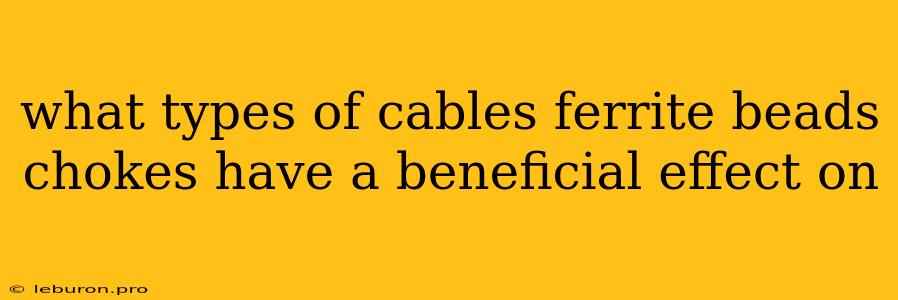Ferrite beads and chokes are passive electronic components commonly used to suppress electromagnetic interference (EMI) in electronic circuits. They achieve this by acting as a high-impedance path for high-frequency signals while allowing lower frequencies to pass through. These components can be found in various forms, such as beads, cores, and sleeves, and are often incorporated into cables to prevent unwanted radio frequency interference (RFI) from entering or leaving a device. The effectiveness of ferrite beads and chokes in suppressing EMI depends largely on the specific type of cable and the frequency range of the interference.
Types of Cables Where Ferrite Beads and Chokes Offer Benefits
Ferrite beads and chokes are most effective in suppressing EMI on cables carrying high-frequency signals. These signals can be generated by various sources within electronic devices, including power supplies, switching circuits, and digital logic. Here are some common types of cables where ferrite beads and chokes can have a beneficial effect:
1. Power Cables
Power cables, especially those carrying DC power, can radiate significant amounts of EMI. This is particularly true for high-power applications where large current fluctuations occur. Ferrite beads and chokes can be effectively used to suppress this EMI by attenuating high-frequency noise that can cause interference in nearby devices or circuits.
2. Signal Cables
Signal cables carrying high-frequency signals, such as those used in data communication, video transmission, and audio systems, are susceptible to EMI. The interference can degrade the signal quality, leading to errors, distortion, and other issues. Ferrite beads and chokes can be incorporated into these cables to minimize the amount of noise that is transmitted along the lines.
3. Control Cables
Control cables carrying signals for controlling various functions within a device are also susceptible to EMI. These cables can be sensitive to interference, which can disrupt the proper operation of the controlled system. Ferrite beads and chokes can be used to effectively reduce the amount of EMI that reaches the control circuitry.
4. USB Cables
USB cables are widely used for data transfer and charging electronic devices. These cables can be susceptible to EMI, especially when transmitting data at high speeds. Ferrite beads and chokes are commonly included in USB cables to suppress EMI and ensure reliable data transfer.
5. Ethernet Cables
Ethernet cables are used for transmitting data over a network. They are vulnerable to EMI, which can cause data errors and network instability. Ferrite beads and chokes are often incorporated into Ethernet cables to minimize EMI and ensure smooth network operation.
How Ferrite Beads and Chokes Work
Ferrite materials are ferromagnetic ceramics with high permeability at specific frequencies. When an alternating current flows through a wire wrapped around a ferrite bead or core, the magnetic field generated by the current interacts with the ferrite material. This interaction induces eddy currents within the ferrite, which oppose the flow of the high-frequency current. This opposition creates a high impedance for high-frequency signals, effectively attenuating them.
Factors Affecting Effectiveness
The effectiveness of ferrite beads and chokes in suppressing EMI depends on several factors, including:
- Frequency: Ferrite beads and chokes have a specific frequency range where they are most effective. This range is determined by the material and dimensions of the ferrite component.
- Impedance: The impedance of the ferrite bead or choke is a measure of its ability to resist the flow of high-frequency current. Higher impedance values provide greater suppression.
- Cable Type: The type of cable and its characteristic impedance can affect the effectiveness of the ferrite component. For example, a ferrite bead on a coaxial cable may be more effective than on a twisted pair cable.
- Location: The location of the ferrite bead or choke on the cable is crucial. It should be placed as close as possible to the source of the interference or the sensitive component.
Choosing the Right Ferrite Bead or Choke
Selecting the appropriate ferrite bead or choke for a specific application requires considering several factors, including:
- Frequency range of the interference: The ferrite component should be selected with a frequency range that effectively attenuates the interfering frequencies.
- Impedance requirement: The impedance of the ferrite component should be sufficient to suppress the interference while maintaining acceptable signal integrity.
- Cable type and size: The ferrite component should be compatible with the cable type and size.
- Physical constraints: The size and shape of the ferrite component should be suitable for the application and its mounting location.
Conclusion
Ferrite beads and chokes are essential components for suppressing EMI in electronic circuits. They are particularly effective in reducing interference on cables carrying high-frequency signals. By selecting the right ferrite component and considering the factors discussed above, engineers can effectively minimize EMI and ensure the reliable operation of electronic devices. Ferrite beads and chokes continue to play a crucial role in mitigating EMI and ensuring electromagnetic compatibility (EMC) in various electronic applications.
